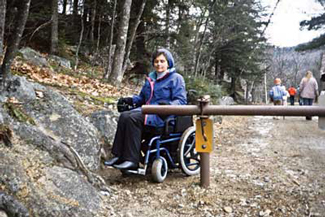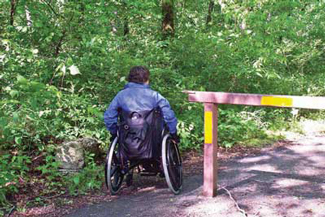Foot Travel on Trails and Roads With Restrictions
When gates, barriers, or berms are installed on a trail or a road to close it to motorized traffic or for other purposes, but foot travel is encouraged beyond the closure, people who use wheelchairs that meet the legal definition must be able to get behind the closure, as required by Section 504 of the Rehabilitation Act of 1973. As explained in "Program Accessibility" of this guidebook, a wheelchair is permitted anywhere foot travel is permitted.
When foot travel is encouraged beyond a closure, the Office of General Counsel of the U.S. Department of Agriculture has determined that a minimum of 36 inches (915 millimeters) of clear passage must normally be provided around or through the gate, berm, or other restrictive device (figures 21 and 22) to ensure that a person who uses a wheelchair can participate in the opportunity behind the restriction. This clear passage is required by the accessibility guidelines as explained in "Gates and Barriers" of this guidebook. Various methods can provide pedestrian passage around a restrictive device, but prevent passage by animals or vehicles that are not allowed beyond the gate or barrier. The Forest Service has developed designs for the tech tip "Accessible Gates for Trails and Roads." These gate designs can be locally constructed from materials appropriate to the setting. The plans are available at http://www.fs.fed.us/recreation /programs/accessibility/pubs/htmlpubs/htm06232340/index.htm and http://www.fhwa.dot.gov/environment/fspubs/.

Figure 21—This road closure gate does not provide enough clearance to allow pedestrian passage.

Figure 22—One way to get around a vehicle road closure gate: a paved bypass.
Indications that foot travel is encouraged include:
-
Destination signing
-
A pedestrian recreation symbol without a slash
-
A Forest Service map that highlights an opportunity behind the closure
-
A trail management objective or road management objective stating that pedestrian use is encouraged
In areas where foot travel isn't encouraged, but occasional pedestrian use is allowed before and after installation of the restriction device, work with individuals who use wheelchairs to determine the best solution.

User Comments/Questions
Add Comment/Question